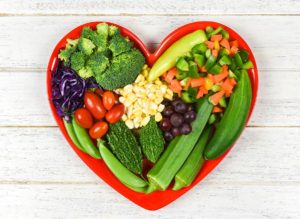 When it comes to “eating your fruits and veggies,” one fruit or vegetable doesn’t protect you anymore than one vitamin supplement does. In our senior War on Aging, we need to eat a variety of foods containing antioxidants that control the free radical oxidative stress rampant in our bodies.
When it comes to “eating your fruits and veggies,” one fruit or vegetable doesn’t protect you anymore than one vitamin supplement does. In our senior War on Aging, we need to eat a variety of foods containing antioxidants that control the free radical oxidative stress rampant in our bodies.
Recall what this means: Free radicals are produced when the body breaks down food, or when a body is exposed to toxins such as tobacco smoke, alcohol, pollutants and radiation. Antioxidants are the “good guys.” They protect the cells against free radicals (unpaired electrons), thereby slowing down the ravages of cellular imbalance.
If you decide, for example, to eat five cups of strawberries a day because they contain important antioxidants, you would not be getting the range of substances necessary for good health and longevity. One antioxidant-rich food cannot do the work of all the antioxidants. The best way to minimize the damage done by free radical production from metabolism is to eat a wide range of fruits and vegetables containing all the antioxidants.
Free Radicals vs. Antioxidants
So, when it comes to aging, the war is fought intra-cellular, free radicals versus antioxidants. Scientists discovered antioxidants and their role in combating the effects of free radicals in the 1990s. They found that those people with vision loss, atherosclerosis, cancer, and other chronic conditions were lacking antioxidants in their bodies. Later studies found that low intakes of antioxidant-rich fruits and vegetables were at greater risk of developing chronic conditions than those who ate a varied diet.
Here’s the thing, though. At that time, supplement manufacturers jumped on the promotional bandwagon for antioxidant pills. Later it was found that supplements simply did not protect against heart disease, cancer and other diseases in the same way that eating healthy food did.
The fact is that one cup of fresh strawberries contains about 80 mg. of vitamin C—a vitamin known to have high antioxidant activity. Taking a vitamin C supplement, even at high dose, doesn’t have the polyphenols that are naturally found in strawberries which join forces with the vitamin C to fight disease as a team.
Similarly, while there are eight chemical forms of vitamin E present in foods, vitamin E supplements typically contain only one form of the vitamin, alpha-tocopherol.
Ten Foods Highest in Antioxidants
So, you may wonder what foods you should eat to gain the greatest benefits from the antioxidants, allowing your body to best fight free radicals. These foods include:
- Almonds, avocado, sunflower seeds, boiled spinach, red peppers, peanuts, leafy greens, and Swiss chard all contain high levels of Vitamin E.
- Broccoli, bell peppers, Brussels sprouts, tomatoes, cantaloupe, sweet potatoes, cauliflower, strawberries, grapefruit, honeydew, kiwi, snow peas, papaya, oranges, lemons, and kale are chock-full of Vitamin C.
- Brazil nuts, brown rice, barley, shellfish, fish, poultry, and beef contain high levels of Selenium.
- Watermelon, apricots, asparagus, tomatoes, tangerines, broccoli, beets, sweet potatoes, cantaloupe, kale, bell peppers, carrots, winter squash, spinach, mangos, pink grapefruit, collard greens, peaches, oranges, and turnip greens are full of carotenoids, including lycopene and beta-carotene.
- Onions, red wine, and apples contain Quercetin.
- Tea, cocoa, and berries contain catechins.
- Berries, peanuts, red and white wines, and grapes contain resveratrol.
- Berries and spices contain coumaric acid.
- Blueberries and strawberries contain anthocyanins.
- Fortified cereals, cashews, chickpeas, lentils, pumpkin seeds, shrimp, oysters, sesame seeds, poultry, and beef contain zinc.
As you may have noticed, some foods (many of those that are classified as “superfoods”) contain more than one form of antioxidant. Berries are a good example of this, containing anthocyanins, coumaric acid, resveratrol, catechins, and vitamin C.
The Antioxidant Food Bottom Line
When taken out of their natural context, it is less certain just how much effect antioxidants have on the free radicals that contribute to cancer, vision loss, cognitive decline, heart disease, and other chronic diseases. Studies are inconclusive but seem to suggest that supplements simply don’t offer the same level of free-radical fighting antioxidants as the healthy foods themselves do.
That being said, there is plenty of evidence to support the fact that eating whole grains, fruits, and vegetables sends disease-fighting antioxidants to battle free radicals, protecting the body against the negative aspects of aging.
In the end, while you simply cannot avoid exposure to free radicals and the resulting oxidative stress entirely, you do have the power to make good lifestyle choices for your health and your future.
Covering the Anti-Aging Bases
I don’t know about you, but I cover my bases. I take a variety of vitamins and minerals as supplements as well as strive for variety and color in choosing vegetables and fruits. Yes, some of the excess is wasted. But I’d rather have excess than deficit when it comes to fueling my aging body. I do try to buy supplements from reputable manufacturers who use quality ingredients.
It’s a constantly changing marketplace and not everything is worthwhile. That’s why I read as much as possible on the changing landscape of nutritional and longevity science. A couple of good resources for supplements are Terry Grossman and Ray Kurzweil’s site Transcend, and the Life Extension Foundation.
As we continue the adventure into 2021, we are wishing you good health and happiness, from myself and husband Rob Krakoff. Rob’s currently battling health problems in a hospital and will return this week. While he loves hospital red jello, he finally admits he prefers my cooking.

Recent Comments